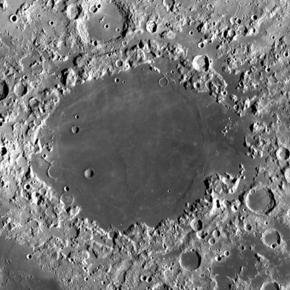


LRO image
| |
| Coordinates | 17°00′N 59°06′E / 17.0°N 59.1°E / 17.0; 59.1 |
|---|---|
| Diameter | 556 km (345 mi)[1] |
Mare Crisium /ˈkrɪsiəm/ (Latin crisium, the "Sea of Crises") is a lunar mare located in the Moon's Crisium basin, just northeast of Mare Tranquillitatis. Mare Crisium is a basin of Nectarian age.[2]
Mare Crisium is 556 km (345 mi) in diameter,[1] and 176,000 square kilometres (68,000 sq mi) in area. It has a very flat floor, with a ring of wrinkle ridges (dorsa) toward its outer boundaries. These are Dorsa Tetyaev, Dorsum Oppel, Dorsum Termier, and Dorsa Harker. The cape-like feature protruding into the southeast of the mare is Promontorium Agarum. On the western rim of the mare is the palimpsest Yerkes, and Lick to the southeast is similar. The crater Picard is located just to the east of Yerkes, and northwest of Picard are the craters Peirce and Swift. The ray system of the crater Proclus overlie the northwestern mare. Mare Anguis can be seen northeast of Mare Crisium.[3]
Amass concentration (mascon), or gravitational high, was identified in the center of Mare Crisium from Doppler tracking of the five Lunar Orbiter spacecraft in 1968.[4] The mascon was confirmed and mapped at higher resolution with later orbiters such as Lunar Prospector and GRAIL.
Like most of the other maria on the Moon, Mare Crisium was named by Giovanni Riccioli, whose 1651 nomenclature system has become standardized.[5]
By the 17th century, Mare Crisium had acquired the name 'Caspian Sea', being labelled as such by Thomas Harriot, Pierre Gassendi and Michael van Langren. Ewen A. Whitaker speculates that it received this name because it occupies roughly the same position on the Moon's face as does the Caspian Sea on Earth, with respect to maps of Europe, North Africa and the Middle East.[6] The English astronomer William Gilbert's map of c.1600 calls it 'Brittania' after Britain.[6]
Mare Crisium is just visible from Earth with the naked eye as a small dark spot on the edge of the Moon's face.
It is the site of the crash-landing of Soviet Luna 15 probe in 1969. A soil sample from Mare Crisium was successfully brought to Earth on 22 August 1976 by the Soviet lunar mission Luna 24.[citation needed]
Mare Crisium is used as the location for Arthur C. Clarke's 1948 seminal short-story "The Sentinel". In the story, a mysterious structure is found in one of the mountains surrounding the Mare. Clarke describes Mare Crisium as follows:[7]
It is the great walled plain, one of the finest on the Moon, known as the Mare Crisium - the Sea of Crises. Three hundred miles in diameter, and almost completely surrounded by a ring of magnificent mountains, it had never been explored until we entered in the late summer of 1996.
| Authority control databases: National |
|
|---|